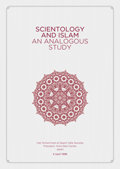Both Islamic philosophy and Scientology philosophy agree that man is composed of spirit, soul and body.
Allamah Sayyid Mohammed Husayn Tabatabai explained the Islamic position best as follows:
Those who are acquainted to a certain extent with the Islamic sciences know that within the teachings of the Holy Book and the traditions of the Prophet there are many references to spirit and corpus, or soul and body. Although it is relatively easy to conceive of the body and what is corporeal, or that which can be known through the senses, to conceive of spirit and soul is difficult and complicated.
People given to intellectual discussions, such as the theologians and philosophers, Shi’ite and Sunni alike, have presented different views concerning the reality of spirit (ruh). Yet, what is to some extent certain is that Islam considers spirit and body to be two realities opposed to each other. The body through death loses characteristics of life and gradually disintegrates, but it is not so with the spirit. Rather, life in its origin and principle belongs to the spirit. When the spirit is joined to the body, the body also derives life from it, and when the spirit separates from the body and cuts its bond to the body—the event that is called death—the body ceases to function while the spirit continues to live.
Mr. Hubbard describes the parts of man in the book Scientology: The Fundamentals of Thought as follows:
The individual man is divisible into three parts.
The first of these is the spirit, called in Scientology the THETAN.
The second of these parts is the MIND.
The third of these parts is the BODY.
He continues:
These three Parts of Man—the thetan, the mind and the body—are each one different studies, but they influence each other markedly and continually. Of the three, the senior entity is the thetan. For without the thetan, there would be no mind or animation in the body. While without a body or a mind, there is still animation and life in the thetan.
The thetan is the person. You are YOU in a body.
From a Scientology point of view the thetan lives on after death, as the thetan is immortal. This can be seen to be very much in keeping with the Islamic beliefs of the spirit.
A sub-study of Scientology is Dianetics. This was first introduced as a study of the mind, but later as the development of this study grew it was further redefined as a study of “What the soul is doing to the body.” Scientology was similarly further redefined as “The study and handling of the spirit in relationship to itself, universes and other life.”
From a Scientology point of view the thetan lives on after death, as the thetan is immortal. This can be seen to be very much in keeping with the Islamic beliefs of the spirit.
The similarities are further emphasized by this statement by Mr. Hubbard: “However, as studies have gone forward, it has become more and more apparent that the senior activity of life is that of the thetan and that in the absence of the spirit no further life exists.”
Thus one can see that what is termed spirit, soul and body, as well as life and death, have much agreement with each other in both Islam and Scientology philosophies.





























